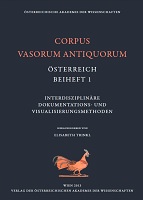Interdisziplinäre Dokumentations- und Visualisierungsmethoden
| dc.contributor.author | Trinkl, Elisabeth | |
| dc.date.accessioned | 2013-12-31 23:55:55 | |
| dc.date.accessioned | 2020-02-04 11:54:12 | |
| dc.date.accessioned | 2020-04-01T14:58:20Z | |
| dc.date.available | 2020-04-01T14:58:20Z | |
| dc.date.issued | 2013 | |
| dc.identifier | 453483 | |
| dc.identifier | OCN: 882577256 | en_US |
| dc.identifier.uri | http://library.oapen.org/handle/20.500.12657/33850 | |
| dc.description.abstract | This publication focuses on (natural) scientific methods in studying and analyzing ancient pottery and discusses several case studies of the application on ancient vases stored in the Kunsthistorisches Museum Wien, Universalmuseum Joanneum Graz, and Collection of the Karl-Franzens-Universität Graz. So called non-invasive methods (without sampling) are favored, e. g. using high-resolution computer tomography, X-ray fluorescence analysis. | |
| dc.language | English | |
| dc.language | German | |
| dc.subject.classification | thema EDItEUR::N History and Archaeology::NK Archaeology | en_US |
| dc.subject.other | Pottery, ceramics, scientific diagnosis, Greek | |
| dc.subject.other | Keramik, naturwissenschafltiche Methoden, griechisch | |
| dc.title | Interdisziplinäre Dokumentations- und Visualisierungsmethoden | |
| dc.type | book | |
| oapen.abstract.otherlanguage | Die Publikation stellt neue Methoden zur Erforschung antiker Keramik vor und beschreibt deren Einsatz anhand ausgewählter Vasen aus folgenden Museen: Kunsthistorisches Museum Wien, Universalmuseum Joanneum Graz, Sammlung der Karl-Franzens-Universität Graz. Dabei wird besonderer Wert auf die Anwendung und Entwicklung sog. zerstörungsfreier Methoden gelegt, z. B. Computertomographie, Röntgenfluoreszenz. | |
| oapen.identifier.doi | 10.26530/oapen_453483 | |
| oapen.relation.isPublishedBy | ca6d9b4e-9864-42c7-af46-370561fe314c | |
| oapen.relation.isFundedBy | 26ae1657-c58f-4f1d-a392-585ee75c293e | |
| oapen.collection | Austrian Science Fund (FWF) | |
| oapen.collection | AG Universitätsverlage | |
| oapen.pages | 216 | |
| oapen.grant.number | PUB 17 |

